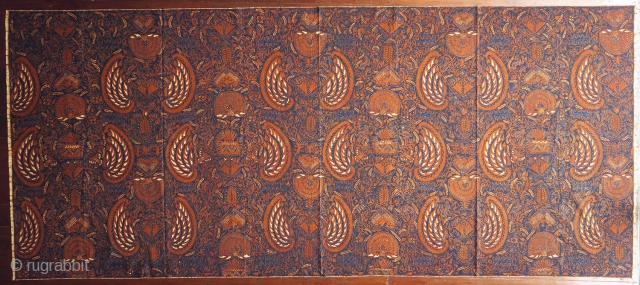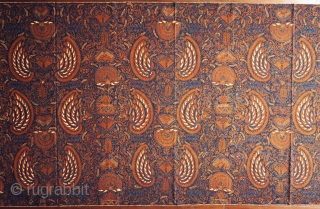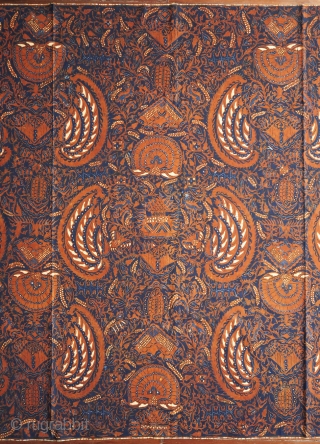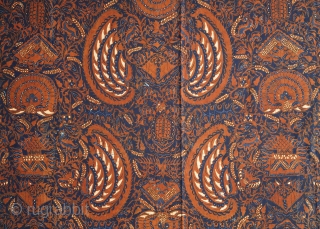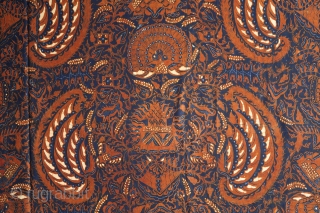Back
Batik skirt cloth (kain panjang)
Origin: Indonesia, Java, Yogyakarta, c. 1950
Technique: Hand-drawn (tulis) batik, natural indigo and soga dyes
Description: a densely drawn, semi-abstract design belonging to the most complex group of semen (from semi, meaning “to sprout”) patterns that symbolize the fertility of the natural world. The principal ornaments are arranged in vertical columns relative to the dominant motif of paired wings and a tail representing the Garuda—a symbol of nobility. Two structural motifs stand out amidst a wealth of curvilinear forms suggesting leaves, tendrils, fruits, and padi stalks. a surprising detail is a tiny pair of four-legged animals that change the scale of the picture when they are detected. The largely brown motifs are detailed with blue lines that emphasize their shape, and are further filled with tiny white dots that give the motifs a sharp, refined definition. The spontaneous free-hand drawing has the depth of suggestiveness of traditional central Javanese batik.
Context: Semen designs are the most important group of non-geometric batik patterns. They derive from pre-Islamic cosmology, and were previously reserved for royalty.
Condition: Excellent, the piece appears virtually unused. The cotton is stiff, thick and crisp with age, and the colours are rich, deep and unfaded.
Dimensions: Length: 241 cm. Width: 105 cm.
Origin: Indonesia, Java, Yogyakarta, c. 1950
Technique: Hand-drawn (tulis) batik, natural indigo and soga dyes
Description: a densely drawn, semi-abstract design belonging to the most complex group of semen (from semi, meaning “to sprout”) patterns that symbolize the fertility of the natural world. The principal ornaments are arranged in vertical columns relative to the dominant motif of paired wings and a tail representing the Garuda—a symbol of nobility. Two structural motifs stand out amidst a wealth of curvilinear forms suggesting leaves, tendrils, fruits, and padi stalks. a surprising detail is a tiny pair of four-legged animals that change the scale of the picture when they are detected. The largely brown motifs are detailed with blue lines that emphasize their shape, and are further filled with tiny white dots that give the motifs a sharp, refined definition. The spontaneous free-hand drawing has the depth of suggestiveness of traditional central Javanese batik.
Context: Semen designs are the most important group of non-geometric batik patterns. They derive from pre-Islamic cosmology, and were previously reserved for royalty.
Condition: Excellent, the piece appears virtually unused. The cotton is stiff, thick and crisp with age, and the colours are rich, deep and unfaded.
Dimensions: Length: 241 cm. Width: 105 cm.
price:
SOLD
- Home
- Antique Rugs by Region
- Category
- Profiles
- Post Items Free
- Albums
- Benaki Museum of Islamic Art
- Budapest: Ottoman Carpets
- Gulbenkian Museum
- Islamic Carpets. Brooklyn
- Islamic Textiles. Brooklyn
- Konya Museum: Rugs
- MKG, Hamburg
- MMA: Caucasian Carpets
- MMA: Mamluk Carpets
- MMA: Mughal Indian Carpets
- MMA: Ottoman Carpets
- MMA: Safavid Persian Carpets
- MMA: Turkmen Rugs
- McCoy Jones Kilims
- Ottoman textiles. Met
- Philadelphia Museum
- Rugs and Carpets: Berlin
- Seljuqs at the Met
- TIEM, Istanbul: Carpets
- V&A: Classical Carpets
- Vakiflar Carpets: Istanbul
- Baluch Rugs: Indianapolis
- Gallery Exhibitions
- Jaf an Exhibition
- Alberto Levi Gallery
- Andean Textile
- Christie's London: 2016
- Francesca Galloway
- HALI at 40
- ICOC Washington, DC 2018
- Jajims of the Shahsavan
- London Islamic Week April, 2018
- Mongolian Felts
- Navajo Rugs: JB Moore
- Persian Piled Weavings
- SF Tribal & Textile Art Show 2020
- SF Tribal 2019
- Sotheby's: C. Alexander
- Turkish Prayer Rugs
- Turkmen Main Carpets ICOC 2007







